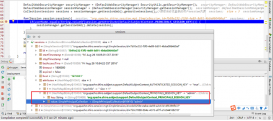因为看StringBuffer 和 StringBuilder 的源码时发现两者都继承了AbstractStringBuilder,并且很多方法都是直接super的父类AbstractStringBuilder的方法,所以还是决定先看AbstractStringBuilder的源码,然后再看StringBuffer 和 StringBuilder.
位置:java.lang包中
声明: abstract class AbstractStringBuilderimplements Appendable, CharSequence
AbstractStringBuilder 类有abstract 修饰,可知它不能被实例化。
AbstractStringBuilder 类有两个子类:StringBuilder和StringBuffer。
字段
|
1
2
3
4
5
6
7
8
|
/** * The value is used for character storage. */ char value[]; /** * The count is the number of characters used. */ int count; |
构造器
1、无参构造器
|
1
2
|
AbstractStringBuilder() { } |
2、创建abstractstringbuilder实现类的对象时指定缓冲区大小为capacity。
|
1
2
3
|
AbstractStringBuilder(int capacity) { value = new char[capacity]; } |
当子类StringBuilder或StringBuffer实例化时,会在构造器中调用此构造器。
扩充容量
void expandCapacity(int minimumCapacity)
此方法有包访问权限,类中有多个方法会调用此方法,在容量不足时扩充容量。
源码:
|
1
2
3
4
5
6
7
8
9
|
void expandCapacity(int minimumCapacity) { int newCapacity = (value.length + 1) * 2; if (newCapacity < 0) { newCapacity = Integer.MAX_VALUE; } else if (minimumCapacity > newCapacity) { newCapacity = minimumCapacity; } value = Arrays.copyOf(value, newCapacity); } |
将缓冲区长度加1乘2的值赋予变量newCapacity, 然后将此值与指定的值比较,将较大值确定为缓冲区的新容量;然后调用Arrays类的copyof方法,此方法会创建一个新数组,然后将原数组中的字符全部复制进新数组中。
ensureCapacity(int minimumCapacity)
|
1
|
public void ensureCapacity(int minimumCapacity) |
确保容量至少等于指定的最小值。如果当前容量小于指定值,则创建新数组,新数组的容量为指定值的两倍加2;如果当前容量不小于指定值,则直接不做处理。
源码:
|
1
2
3
4
5
|
public void ensureCapacity(int minimumCapacity) { if (minimumCapacity > value.length) { expandCapacity(minimumCapacity); } } |
测试:
|
1
2
3
4
5
6
7
8
|
StringBuffer s = new StringBuffer();System.out.println("容量:" + s.capacity());// 容量:16s.ensureCapacity(10);System.out.println("容量:" + s.capacity());// 容量:16s.ensureCapacity(30);System.out.println("容量:" + s.capacity());// 容量:34s.ensureCapacity(80);System.out.println("容量:" + s.capacity());// 容量:80 |
方法
codePointAt方法中都是用Character.codePointAtImpl(value, index, count)来实现的
|
1
2
3
4
5
6
|
public int codePointAt(int index) { if ((index < 0) || (index >= count)) { throw new StringIndexOutOfBoundsException(index); } return Character.codePointAtImpl(value, index, count); } |
getChars方法的实现用的是System.arraycopy()方法
|
1
2
3
4
5
6
7
8
9
10
|
public void getChars(int srcBegin, int srcEnd, char[] dst, int dstBegin) { if (srcBegin < 0) throw new StringIndexOutOfBoundsException(srcBegin); if ((srcEnd < 0) || (srcEnd > count)) throw new StringIndexOutOfBoundsException(srcEnd); if (srcBegin > srcEnd) throw new StringIndexOutOfBoundsException("srcBegin > srcEnd"); System.arraycopy(value, srcBegin, dst, dstBegin, srcEnd - srcBegin); } |
append方法都牵扯到了ensureCapacityInternal()方法和getChars()方法来实现
|
1
2
3
4
5
6
7
8
9
|
public AbstractStringBuilder append(String str) { if (str == null) return appendNull(); int len = str.length(); ensureCapacityInternal(count + len); str.getChars(0, len, value, count); count += len; return this; } |
使用了Arrays.copyOf()来实现
|
1
2
3
4
5
6
7
8
9
10
11
|
void expandCapacity(int minimumCapacity) { int newCapacity = value.length * 2 + 2; if (newCapacity - minimumCapacity < 0) newCapacity = minimumCapacity; if (newCapacity < 0) { if (minimumCapacity < 0) // overflow throw new OutOfMemoryError(); newCapacity = Integer.MAX_VALUE; } value = Arrays.copyOf(value, newCapacity); } |
Arrays.fill(value, count, newLength, ‘\0');字符串之间的复制
|
1
2
3
4
5
6
7
8
9
10
11
|
public void setLength(int newLength) { if (newLength < 0) throw new StringIndexOutOfBoundsException(newLength); ensureCapacityInternal(newLength); if (count < newLength) { Arrays.fill(value, count, newLength, '\0'); } count = newLength; } |
delete() 仅改变字符串的大小并未真正的删除字符串
|
1
2
3
4
5
6
7
8
9
10
11
12
13
14
|
public AbstractStringBuilder delete(int start, int end) { if (start < 0) throw new StringIndexOutOfBoundsException(start); if (end > count) end = count; if (start > end) throw new StringIndexOutOfBoundsException(); int len = end - start; if (len > 0) { System.arraycopy(value, start+len, value, start, count-end); count -= len; } return this; } |
学会灵活的运用System.arraycopy()方法
|
1
2
3
4
5
6
7
8
9
10
11
12
13
14
15
|
public AbstractStringBuilder insert(int index, char[] str, int offset, int len) { if ((index < 0) || (index > length())) throw new StringIndexOutOfBoundsException(index); if ((offset < 0) || (len < 0) || (offset > str.length - len)) throw new StringIndexOutOfBoundsException( "offset " + offset + ", len " + len + ", str.length " + str.length); ensureCapacityInternal(count + len); System.arraycopy(value, index, value, index + len, count - index); System.arraycopy(str, offset, value, index, len); count += len; return this; } |
总结
以上就是本文关于源码详细解读AbstractStringBuilder类源码详细解读的全部内容,希望对大家有所帮助。感兴趣的朋友可以继续参阅本站其他相关专题,如有不足之处,欢迎留言指出。感谢朋友们对本站的支持!
原文链接:http://blog.csdn.net/freedom_wei/article/details/50345645














